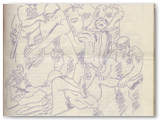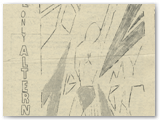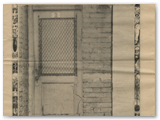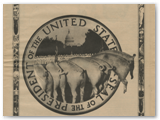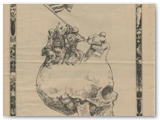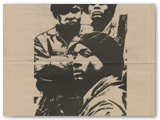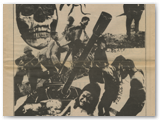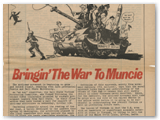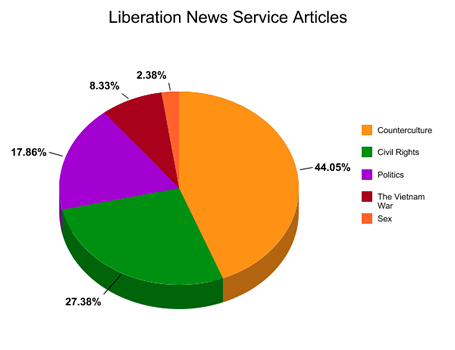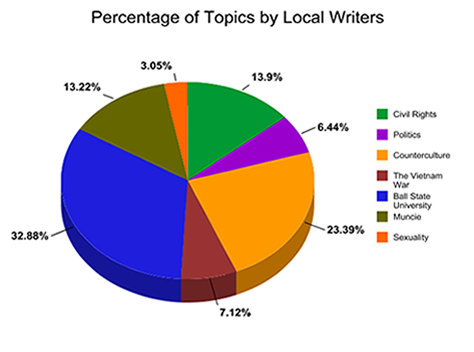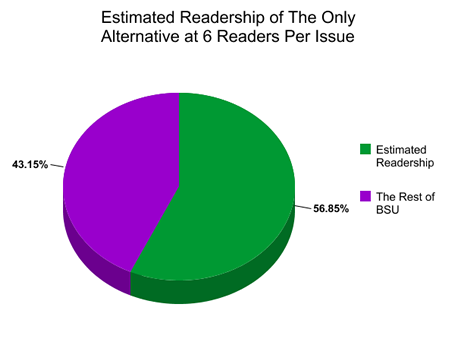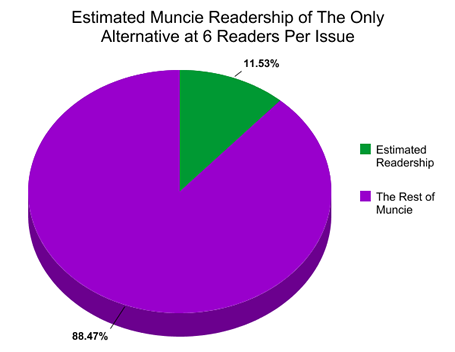History of The Only Alternative:
Beginning in September 1968, an underground newspaper called The Only Alternative (TOA) began showing up in Ball State University's Talley Student Center and street vendors in the Muncie, Indiana area. Three years later, The Only Alternative ended its run with a total of 28 issues containing articles about the Ball State administration, the Muncie community, the Civil Rights Movement, and the Counterculture. During its run, TOA proved to be both controversial and enlightening for readers. Today it stands as an excellent source for examining the late 1960s and early 1970s both at Ball State and the Muncie community as well as an example of the Underground Press which became popular across the country at that time.
The Only Alternative was created by William Harriff, his wife Sue Harriff, and Dave Auble in the fall of 1968. The Harriffs began printing the paper out of their house on McKinley Avenue in Muncie. William Harriff, a political science student, was heavily involved in both the Students for a Democratic Society (SDS) and the Ball State Student Liberal Action Movement (SLAM). In addition to being the headquarters for The Only Alternative, the Harriff's house also served as the office for SLAM and the Socialist Party U.S.A. in Muncie, of which Harriff was a member. As a politically active student, William Harriff participated in anti-Vietnam protests and other political events on the Ball State campus. (Daily News, December 20, 1968, pg. 1) With his strong involvement in political societies, Harriff joined many others across the country who sought to use newspapers as a way to bring attention to events and issues which the mainstream news had largely ignored or misunderstood.
From the beginning, TOA was closely associated with SDS. Though the newspaper was not funded by the group, SDS members made up a large portion of TOA's staff. (Daily News, December 10, 1968, 3, 8) In fact, the first issue features a multi-page article which introduces the reader to SDS. Additionally, several issues contain advertisements for both the SDS and SLAM organizations and meetings. Staff members of TOA were involved with other associations including the Ball State John Brown Society and LeMar (an organization dedicated to the legalization of marijuana).
In the first issue, the editors of TOA wrote an article entitled "The C.I.A. Won't Help...Will You?" In addition to asking for contributions to the newspaper, the first half of this article served as a mission statement for the newspaper:
It’s true – the CIA doesn’t think much of our efforts, and consequently they can’t find any money for us. But even without “official” sanction, we plan to keep trying. “The Only Alternative” will appear as long as we can scrape together money for paper and ink and people. We will try to present to you our side of the issues – the political issues, the moral issues, the spiritual issues. The issues as a radical sees them. Moreover, we’ll even throw in poetry, artwork, etc., if you want it. (The Only Alternative Vol. I No. 1, pg. 2)
While they were obviously joking about seeking C.I.A. support, TOA believed that, while they did not have official support from the University, they were going to provide the student body with something they needed and would support. This paragraph also illustrates one of the main differences between newspapers like the Ball State Daily News and the other Muncie newspapers. While those papers simply printed stories and articles which were approved by their editors, The Only Alternative sought to print what their readers wanted. The newspaper served a specific Countercultural community in Muncie who could both contribute and read news aimed at people with similar interests and viewpoints. The second half of "The C.I.A. Won't Help Us" also illustrates this point:
But we will fail, eventually, without YOUR help. If you want to see another side, another view, read us. If there’s enough demand, we will probably go on sale, a nickel or even a dime. But right now, we can use donations. Money, paper, articles, letters – you name it. If you believe in truly FREE society, and if you believe we have a RIGHT to be heard, help us. The CIA won’t. Will you? (The Only Alternative Vol. I No. 1, pg. 2)
In addition to building and strengthening the local Countercultural community, TOA also spread the viewpoints of the New Left to many people who had not been exposed to a more liberal viewpoint. With both of the Muncie newspapers, the Muncie Star and the Muncie Evening Press, published by Eugene Pullium's Central Newspapers, Inc. presenting a more conservative viewpoint and the Ball State Daily News presenting viewpoints in line with the University administration, TOA truly offered the only alternative to these viewpoints. TOA not only introduced readers to a more liberal viewpoint, many of the topics which the articles address were not covered or inadequately covered in the other local newspapers. While the content of the articles and a deeper analysis of TOA is discussed here, with articles entitled "An Alternative Life Style," "Bananas Up the Ass," and "Muncie's Pigs are on the Job," and its eye-catching covers, it is easy to see that The Only Alternative truly presented a different set of stories than the alternative sources for local news.
For the first five issues which make up the first volume, TOA consisted of material generated by local students from both Ball State and local high schools. In January 1969, for the beginning of the second volume, TOA joined the Liberation News Service (LNS). LNS cost $15 per month for underground publications. LNS allowed TOA to provide a more national scope to the paper through their weekly news packets. As a member of LNS, TOA could print articles on topics like the Kent State Massacre, anti-war protests in Washington, D.C., and prison riots in Texas without actually sending a staff member to investigate these events. Often the LNS articles would be told from a first-person viewpoint, a style mimicked by several TOA writers. (Glessing, 73-76; Armstrong, 106-107)
By joining LNS, The Only Alternative was able to broaden its subject matter to include a more national scope. The graphs below illustrate the differences between the content of the LNS articles in TOA compared to those written by local writers from Ball State and the Muncie community.
As the LNS articles obviously did not discuss Muncie or Ball State, they have a significantly higher percentage of articles on the Counterculture, Civil Rights Movement, and Politics with similar percentages of articles on Sexuality and Vietnam. These articles discuss events from Washington, D.C. to San Francisco to Latin America. In addition, the LNS articles discuss the Black Panthers, the Oakland Seven, and Beaver 55, three Civil Rights groups outside the mainstream of the Civil Rights Movement. While the articles by local writers feature similar subjects, the LNS articles are often written by people who actually experienced the event, such as the protests at Columbia. In addition, the LNS articles about events such as the Kent State and Jackson State massacres are in much greater detail than those featured in the Daily News about the same events. As a member of LNS, The Only Alternative joined a significant number of the underground newspapers who belonged to the organization. Glessing estimated that LNS had 500 subscribers in 1970. 150 of these were undergrounds while 350 were more mainstream publications. (Glessing, 73)
By the fall of 1969, TOA was hitting its peak, printing 1,500 copies per issue and creating a buzz in both the local newspapers and the Daily News. This changed however when the co-editors Carl Van Buskirk and Dave Johnson left the newspaper. Though it is not entirely clear why they left, it appears that the newspapers stance on illegal drugs had something to do with it. In an interview with the Daily News in January of 1970, Johnson stated that he believed that the paper's stance on drugs was not the main reason they left, he did believe it was important. It is worth noting that TOA averaged one article about drugs per every 2 issues before Van Buskirk and Johnson left and averaged one per issue after. The content of these articles changed as well. The earlier articles discussed the legalization of marijuana and the problems with the local police which resulted from possessing it. After they left the articles focused more on techniques for growing marijuana. In addition to any disagreements which they may have had with the rest of the staff, both men mentioned their workload as seniors as a contributing factor in their departure. This disagreement over the use of illegal drugs is alluded to in multiple Daily News articles and certainly seems to be a contributing factor. (Daily News, January 6, 8, 1970)
Regardless of the reasons, the departure of Van Buskirk and Johnson had a significant impact on the newspaper. After their departure, the spring semester of 1970 only saw two full issues and a third 8 page issue in memorial of Malcolm X which came out sometime after the Kent State and Jackson State shootings in May 1970. The next issue did not arrive until November 1970, once again closely affiliated with the Student Liberal Action Movement at Ball State. The final two issues came in February and April of 1971. As with many other underground newspapers, once the initial leadership left the publication, the newspapers tended to slow down and eventually fall apart. Even though TOA came to an end in 1971, this falls in line with the trend across the nation. By 1972-1973 there was a sharp decline in the Underground Press, something illustrated by the N-Gram seen here:
Though this graph only charts the use of the terms "underground press," "underground newspaper" in the Google books corpus, it suggests that the type of publications which referred to themselves as underground drastically dropped off after 1973, something backed up by the scholarship on the subject. The main contributing factors to this decline were financial issues and internal disagreements which led to the end of many of the publications. The increase in special interest publications also contributed as many people with specific goals and interests left to form magazines like the feminist publication Ms. (1972) or Gay Activist 1970), the publication of the Gay Activist Alliance ((Dennis, 167, Peck 220) In its three years, The Only Alternative managed to bring attention to many events and viewpoints not available to the average Ball State University student.
While the history of The Only Alternative can be pieced together through the issues themselves and articles in the Daily News, it is much more difficult to assess the actual impact of the newspaper. This problem is one that has existed since the 1960s. While it is possible for many newspapers to track their subscriptions and total number of issues sold, that number does not necessarily equal the number of readers. The Underground Press Syndicate estimated that because of the "intensity of the content" of the papers, the readership of each copy was six people. (Glessing, 120-121) Taking this estimate into account, around its peak in the fall of 1969, The Only Alternative could have reached an estimated 9,000 people on a per issue basis. This is using a printing of 1,500 as mentioned by the editors in multiple Daily News articles. (Daily News Dec. 10, 1968, Oct. 27, 1969) During the years from 1968 to 1971, Ball State University averaged 15,830 students a year at the beginning of the fall semesters. With The Only Alternative having an estimate readership of 9,000 per issue, it was reaching an estimated 57% of the student body, a significant percentage. Even at a more conservatively estimated number of 3 readers per issue, the newspaper would have reached 4,500 people per issue or 28% of the student body, still a significant percentage. These numbers are illustrated in the graphs below:
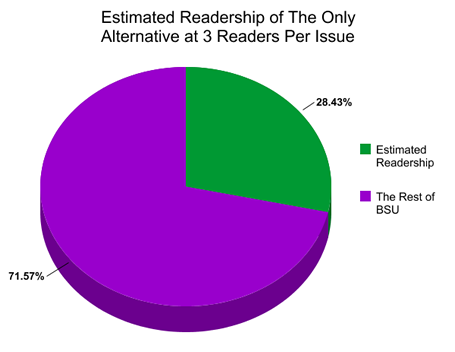
Ball State University Subject Files Box 100 Folder 1, "Total College Level On Campus 1918-1970," Ball State University Libraries Archives and Special Collections
The census data from 1970 shows that the population of the city of Muncie was 69,080 in 1970. With a readership of 9,000 (at 6 readers per issue) and 4,500 (at 3 readers per issue) The Only Alternative would have reached approximately 11.5% and 6.5% respectively. While these numbers may not seem high, the fact that a liberal leaning newspaper printed by a few hardworking undergraduate students could reach as much as 11.5% of the population of a city with their paper is significant. The following graphs illustrate these numbers:

1970 Census of Population and Housing, pg. 16
While Muncie and the Ball State community are known for their apathy during the 1960s, the existence and significant readership of The Only Alternative illustrates that there were a significant number of students and faculty members who were conscious of and interested in the national event of the Sixties. Though The Only Alternative obviously could not compete with the Muncie Star, the Muncie Evening Press, or even the Ball State Daily News in total readership, the fact that approximately 1 in 10 people in Muncie read each issue means that they were exposed to the viewpoints and ideas of the newspaper, making the newspaper a true alternative to the mainstream newspapers.
